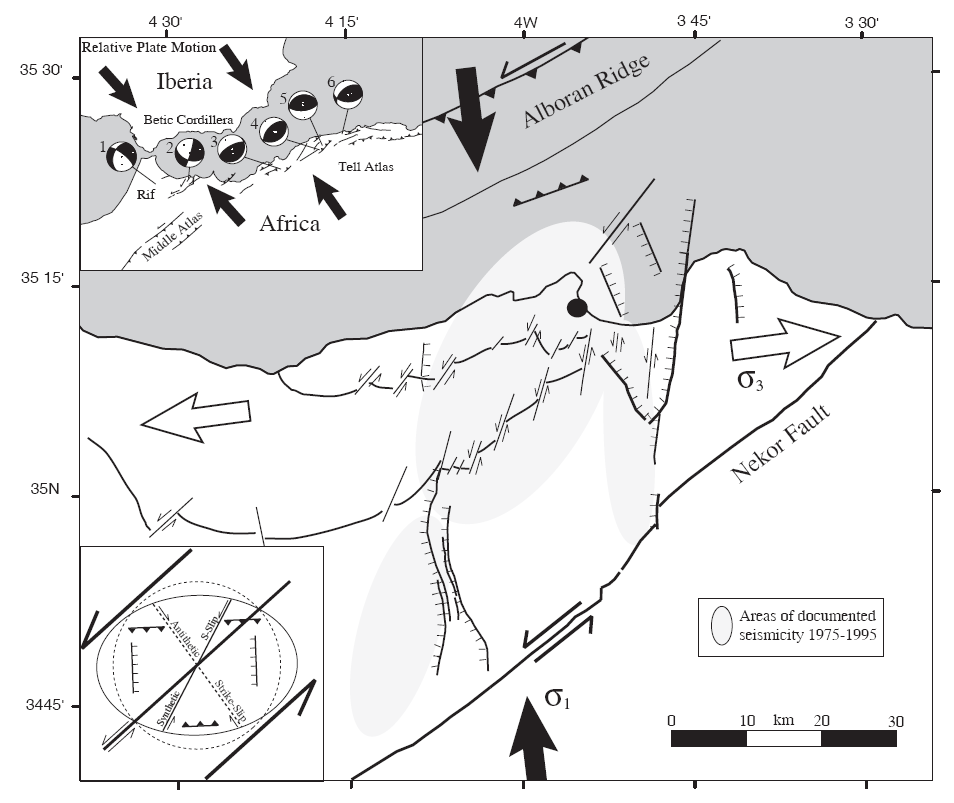
Data produced by the Moroccan national seismological network and marine seismic reflection profiles are used to investigate the most seismically active region in Morocco, located on the Mediterranean coast at the intersection of the Rif mountain belt and the submarine Alboran Ridge. This region, in the vicinity of the city of Al-Hoceima, marks an east-west transition in the marine and land deformation styles of the distributed plate boundary between Africa and Iberia, and was the site of a Mw=6.0 earthquake on May 26, 1994.
The epicenter of the Al-Hoceima earthquake is relocated onshore, refining the initial submarine location close to the Alboran Ridge. The spatial distribution of foreshocks and aftershocks shows a NE-SW trend that continues partly offshore and is subparallel to the earlier, yet still prominent, Miocene geologic structural trend. The predominantly strike-slip focal mechanism for the Al-Hoceima event is characteristic of earthquakes in the region. Marine seismic reflection profiles, that intersect the offshore region of seismicity, image active high angle faults with possible strike-slip components. The seismicity trend is not directly related to the submarine Alboran Ridge or the geomorphologically prominent Nekor fault. Deformation appears to be occurring on a number of subsidiary strike-slip faults that together compose a NE-SW zone of distributed shear.
The distributed strike-slip and documented normal faulting taking place in the eastern Rif mountains, although characteristic of the Rif region, are in contrast to the thrusting style of deformation that occurs farther to the east in the Algerian Tell Atlas. This may be related to the reported lateral variations and evolution of the convergent plate boundary in these regions during the Neogene and Quaternary times.
This paper was published in the Bulletin of the Seismological Society of America by the Seismological Society of America (SSA), and SSA retains the copyright.
Calvert, A., Gomez, F., Seber, D., Barazangi, M., Jabbour, N., Ibenbrahim, A., and Demnati, M. An integrated geophysical investigation of recent seismicity in the Al-Hoceima region of North Morocco, Bulletin of the Seismological Society of America, 87(3), 637-651, 1997, © Seismological Society of America.
Figure 10.
Zones of recent seismicity and model proposing that strike-slip movement along the Jebha and Alboran Ridge bounding faults has resulted in the formation of distributed synthetic strike-slip faults along which seismic deformation is now occurring. Large black and white arrows indicate present ó1 and ó3 directions determined by Medina (1995). Upper Inset: Focal Mechanisms of major earthquakes on the NW African margin and Neotectonic faults (adapted from Meghraoui et al., 1996): (1) Rif 11.15.64 (Medina et al., 1992), (2) Al-Hoceima 05.26.94 (Harvard), (3) Mascara 08.18.94 (Harvard), (4) El Asnam 10.10.80 (Deschamps et al., 1982), (5) El Asnam 09.09.54 (McKenzie, 1972),and (6) Cherchell-Tifaza 10.29.89 (USGS). Black arrows show present plate convergence directions predicted by NUVEL-1A plate motion model (Demets et al., 1994). Lower inset: Strike-slip zone related fault orientations (adapted from Sylvester and Smith, 1976).
